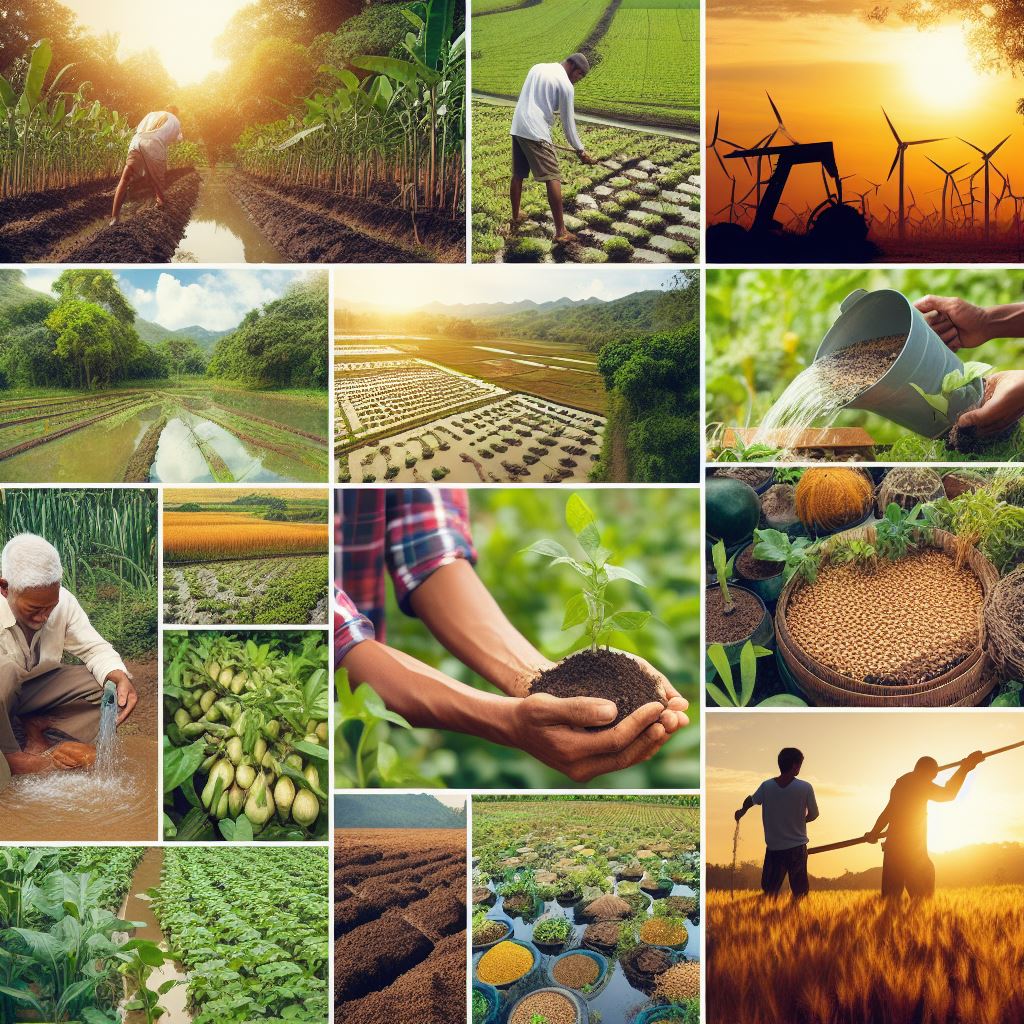Introduction
Climate change is an imminent threat to agriculture, posing significant challenges to crop production.
As extreme weather events become more frequent and unpredictable, the need to develop climate-proof crops has become critical.
These genetically engineered plants are designed to withstand harsh conditions such as drought, floods, and high temperatures, ensuring stable food production even in the face of climate change.
Adapting agriculture to a changing climate is essential to safeguard global food security.
With a rapidly growing population, it is crucial to ensure sufficient food supply, particularly in regions prone to climate-related disasters.
Climate-proof crops offer a promising solution by increasing crop resilience and reducing vulnerability to climatic variations.
This adaptation strategy helps farmers cope with the changing climate while sustaining productivity and livelihoods.
Genetic engineering plays a significant role in developing climate-proof crops.
By manipulating the plant’s genetic material, scientists can introduce desirable traits such as drought tolerance, disease resistance, and increased nutrient content.
This technology enables the transfer of beneficial genes from one plant to another, enhancing crop performance under adverse climate conditions.
Genetic engineering also accelerates the breeding process, allowing the development of climate-proof crops in a shorter time frame.
Climate-proof crops are essential to mitigate the impact of climate change on agriculture and ensure food security.
The genetic engineering approach offers immense potential in developing crops that can withstand extreme weather conditions.
By adopting these innovative strategies, we can build a resilient and sustainable agricultural sector capable of feeding the growing global population in a changing climate.
Understanding Climate-Proof Crops
Definition and characteristics of climate-proof crops
Climate-proof crops are genetically modified plants that possess tolerance and resilience against extreme weather conditions.
Transform Your Agribusiness
Unlock your farm's potential with expert advice tailored to your needs. Get actionable steps that drive real results.
Get StartedThese crops are designed to thrive in unfavorable environments, such as drought, floods, extreme temperatures, and soil salinity.
They exhibit traits like improved water efficiency, increased yield potential, enhanced nutrient uptake, and resistance to pests and diseases.
Climate-proof crops are developed using advanced genetic engineering techniques to introduce specific genes into their DNA.
Examples of existing climate-proof crops and their benefits
Drought-tolerant crops
- Maize: Genetically designed to efficiently use water, resulting in increased yield under drought conditions.
- Rice: Improved drought tolerance helps sustain crop productivity in regions facing water scarcity.
Flood-tolerant crops
- Submergence-tolerant rice: Can survive complete submergence for up to two weeks, minimizing yield losses.
- Flood-tolerant maize: Withstands waterlogging and displays improved performance in flood-prone areas.
Heat-tolerant crops
- Heat-tolerant wheat: Thrives in high-temperature regions, ensuring stable production even during heatwaves.
- Heat-tolerant soybeans: Maintain reproductive ability and yield under extreme heat stress conditions.
Salinity-tolerant crops
- Salt-tolerant tomatoes: Can grow in saline soils, enabling cultivation in coastal areas affected by soil salinity.
- Salt-tolerant potatoes: Suited for marginal lands, reducing pressure on fertile soils while enhancing food production.
The benefits of these climate-proof crops include increased food security, farmer resilience, and reduced environmental impact.
Challenges faced in developing climate-proof crops
Regulatory barriers
- Stringent regulations concerning genetically modified organisms pose hurdles for the development and commercialization of climate-proof crops.
- Complex and expensive approval processes delay the adoption of these crops, limiting their availability for farmers.
Public perception and acceptance
- Concerns and misconceptions surrounding genetic engineering create resistance among consumers and some stakeholders.
- Lack of understanding regarding the safety and benefits of genetically modified crops can hinder their acceptance.
Intellectual property rights
- Intellectual property rights issues restrict access to genetic resources and technologies necessary for crop improvement.
- Licensing agreements and patent restrictions may limit the affordability and availability of climate-proof crops for small-scale farmers.
Uncertain long-term impacts
- Limited knowledge about the potential long-term environmental impacts of genetically modified crops raises concerns.
- Unforeseen ecological consequences and emergence of resistant pests or weeds may pose risks to biodiversity and ecosystem stability.
Overcoming these challenges requires collaboration among scientists, policymakers, farmers, and consumers to address regulatory barriers, improve public awareness, ensure fair access to technology, and conduct rigorous safety assessments.
Climate-proof crops offer a promising solution to cope with the challenges posed by climate change.
By harnessing the power of genetic engineering, these crops can withstand adverse climatic conditions, enhancing food security and agricultural sustainability.
However, addressing the challenges related to regulations, public acceptance, intellectual property rights, and long-term impacts is crucial for the successful deployment of climate-proof crops.
Read: Pest Patterns: Climate Change’s Unseen Effect
Genetic Engineering and Climate-Proof Crops
Explanation of genetic engineering and its role in crop development
Genetic engineering involves manipulating an organism’s genes to introduce desirable traits.
Crop development through genetic engineering allows scientists to enhance crops’ characteristics.
Genes from other organisms can be inserted into crop plants to improve their yield and resistance.
This process enables the creation of climate-proof crops that can withstand extreme weather conditions.
In crop development offers a precise and efficient way to introduce desirable traits.
Genetic modifications used to develop climate-proof crops
Genetic modifications include introducing genes that confer drought tolerance to crops.
Scientists can also modify plants to enhance their ability to withstand heat stress.
Genes responsible for disease resistance can be incorporated into crop plants through genetic engineering.
Crop varieties can be developed with increased tolerance to salinity through genetic modifications.
Genetic engineering enables the production of crops with improved nutrient content and quality.
Advantages of genetic engineering in developing climate-proof crops
Genetic engineering allows for the rapid development of climate-proof crop varieties.
Through genetic modifications, crops can be made more resilient to changing climatic conditions.
Climate-proof crops can provide stable and secure food production in the face of climate change.
Genetic engineering facilitates the development of crops with higher yields and improved nutritional value.
The precision of genetic engineering minimizes the need for chemical interventions in crop production.
Showcase Your Farming Business
Publish your professional farming services profile on our blog for a one-time fee of $200 and reach a dedicated audience of farmers and agribusiness owners.
Publish Your ProfileGenetically modified crops can reduce the overall environmental impact of agriculture by enhancing resource efficiency.
Genetic engineering plays a critical role in developing climate-proof crops.
It enables scientists to introduce desired traits, such as drought tolerance and disease resistance.
Genetic modifications offer various advantages, including increased yield, improved quality, and environmental sustainability.
As climate change continues to impact crop production, genetic engineering provides a promising solution.
By harnessing the power of genetic engineering, we can create crops that can thrive in a changing climate, ensuring food security for future generations.
Read: Carbon Farming: Agriculture’s Climate Promise

Benefits and Potential Drawbacks
Advantages of climate-proof crops for farmers
- Increased crop yield: Climate-proof crops can withstand extreme weather conditions, ensuring higher and more stable yields for farmers.
- Reduced production costs: These crops require less water, fertilizers, and pesticides, resulting in cost savings for farmers.
- Improved resilience: Farmers can minimize the impact of climate change on their livelihoods by cultivating crops that adapt to changing conditions.
- Expanded growing seasons: Climate-proof crops can tolerate temperature fluctuations and be grown in regions previously unsuitable for traditional crops.
- Enhanced food security: With reliable and abundant harvests, farmers can contribute to meeting the world’s growing food demands.
Potential environmental and health concerns related to genetic engineering
- Ecological impact: The introduction of genetically modified organisms (GMOs) may harm beneficial insects, disrupt pollination, and affect biodiversity.
- Gene flow and cross-contamination: GMOs can cross-pollinate with non-GMO crops, leading to unintended genetic modifications and potential loss of genetic diversity.
- Unknown long-term effects: The environmental and health consequences of consuming GMOs are not yet fully understood, warranting caution.
- Allergenicity risks: Genetic modifications may introduce allergenic compounds to crops, posing risks to individuals with allergies.
- Resistance development: Pests and weeds may evolve resistance to the genetic traits engineered into climate-proof crops, leading to the need for stronger pesticides or herbicides.
Importance of proper regulation and evaluation
- Comprehensive risk assessment: Rigorous assessment protocols should be in place to evaluate the safety and environmental impact of climate-proof crops.
- Transparent labeling: Clear and accurate labeling is crucial to enable consumers to make informed decisions about the food they consume.
- Monitoring and post-market surveillance: Continuous monitoring of GMOs’ long-term effects and implementation of mitigation measures are essential.
- Public engagement: Stakeholder participation and public dialogue can ensure that decisions regarding genetic engineering align with society’s values and interests.
- Regulation enforcement: Effective regulation and enforcement mechanisms are necessary to hold companies accountable and ensure compliance with safety standards.
Basically, climate-proof crops offer significant benefits to farmers, including increased yields, reduced production costs, and improved resilience.
However, genetic engineering also raises concerns about its potential environmental and health impacts.
Proper regulation, evaluation, and public engagement are key to addressing these concerns and ensuring the safe and responsible use of genetic engineering to develop climate-proof crops.
By striking the right balance, we can unlock the full potential of this technology while safeguarding human health and the environment.
Read: Floods & Agriculture: Preparing for the Surge
Case Studies
Examples of successful genetic engineering projects for climate-proof crops
- In 2016, scientists developed a genetically modified rice variety that could withstand prolonged droughts.
- In 2018, a genetically engineered maize was created to be resistant to extreme heat conditions.
- Researchers in 2020 successfully enhanced the salt tolerance of wheat using genetic engineering techniques.
Real-life application and impact of these crops in different regions
- The drought-resistant rice variety was adopted by farmers in drought-prone regions of Southeast Asia, leading to increased productivity.
- The heat-tolerant maize has provided a reliable source of food in regions experiencing frequent heatwaves, ensuring food security.
- The salt-tolerant wheat has enabled farmers in saline areas to cultivate crops and improve food production in previously unsuitable regions.
Lessons learned from these case studies
- Genetic engineering has the potential to address specific challenges faced by farmers in different climatic conditions.
- The successful adoption of climate-proof crops highlights the importance of collaboration between scientists, farmers, and policymakers.
- Regulatory frameworks need to be in place to ensure the safe and responsible deployment of genetically modified crops.
- Continuous monitoring and evaluation are essential to assess the long-term sustainability and impact of genetically engineered crops.
Future Directions and Research
Current trends and ongoing research in developing climate-proof crops
- Utilizing advanced breeding techniques to enhance crop resilience to changing environmental conditions.
- Exploring gene editing technologies, such as CRISPR, to develop crops with improved tolerance to abiotic stresses.
- Investigating the use of precision agriculture and sensor technologies to optimize crop responses to climate change.
- Studying the potential of crop wild relatives to provide valuable genetic traits for climate-proofing cultivated crops.
- Analyzing the impact of climate change on pests and diseases to devise effective strategies for crop protection.
The role of public and private sectors in supporting research and development
- Public-sector institutions play a crucial role through funding research, collaborating with scientists, and sharing resources.
- Private sector investments enable the development of innovative technologies and their integration into practical solutions.
- Partnerships between public and private sectors can foster knowledge exchange and expedite the translation of research into agriculture.
Promising areas for future genetic engineering advancements
- Enhancing drought tolerance by manipulating genes involved in water-use efficiency and osmotic adjustment.
- Developing crops with increased heat tolerance through the modification of genes related to heat-shock proteins.
- Improving nutrient uptake efficiency and enhancing crop productivity in nutrient-poor soils by optimizing genes involved in nutrient acquisition.
- Engineering crops with enhanced resistance to flooding by introducing genes for submergence tolerance.
- Modifying the flowering time and photoperiodic responses of crops to ensure synchronization with changing climatic conditions.
Through relentless research and innovation, we can expedite the development of climate-resistant crops.
Extensive field trials and long-term crop monitoring under diverse climatic conditions aim to validate these crops’ effectiveness.
Advanced techniques, such as genome-wide association studies, help identify key genes and build predictive models for breeding programs.
Governments and funding agencies must allocate substantial resources to support research infrastructure, international collaborations, and scientist training.
Public awareness campaigns can encourage stakeholders to contribute to climate-proof crop research.
Collaboration between public and private sectors can accelerate the availability and adoption of climate-resistant crops.
Public institutions provide expertise and regulatory frameworks; private companies bring technological advancements and market-driven solutions.
Future genetic engineering advancements include enhancing crop tolerance to multiple stresses, improving nutrient-use efficiency, and engineering resistance to pests and diseases.
Novel techniques like RNA interference and synthetic biology hold promise for creating climate-resistant crops.
Ongoing research in climate-resistant crops, focusing on breeding, gene editing, and precision agriculture, is gaining momentum.
Public-private collaborations and genetic engineering advancements offer hope for addressing climate-related challenges in agriculture, ensuring food security and sustainability.
Read: Agroforestry: A Climate-Smart Farming Future
Conclusion
Recap of the importance of climate-proof crops in adapting to climate change
Climate change poses significant challenges to agriculture worldwide, threatening food security and agricultural stability.
The development of climate-proof crops is essential to mitigate the adverse impacts of changing climatic conditions.
Reiteration of the role of genetic engineering in developing such crops
Genetic engineering plays a crucial role in the development of climate-proof crops by enabling scientists to introduce traits that enhance resilience to environmental stresses, such as drought, heat, pests, and diseases.
Through precise manipulation of plant genomes, scientists can create crops that can withstand adverse climatic conditions.
Encouragement for further exploration and support in this field.
As the effects of climate change intensify, the need to develop and deploy climate-proof crops becomes increasingly urgent.
It is crucial for governments, research institutions, and stakeholders to provide funding, support, and a regulatory framework for continued research and development in this field.
Only through sustained efforts and collaboration can we successfully tackle the challenges of climate change in agriculture and ensure global food security for future generations.




